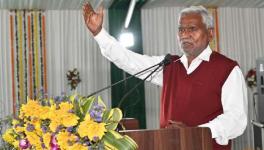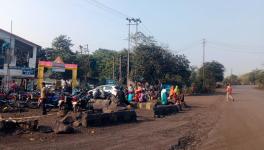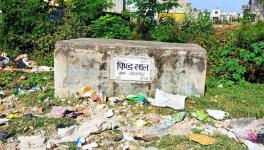Jharkhand: Communities near Coal Mines in Ramgarh Suffering from Severe Chronic Health Problems
Representational use only.
A variety of health complaints – respiratory and musculoskeletal issues, skin problems, hair fall, and cracked soles – occured more prominently among populations living within five kms of coal mines in Mandu block of Jharkhand’s Ramgarh district, revealed a study conducted by the People First Collective India (PFCI), a collective of professionals and social activists.
“The analyses of air, water, soil and sediment samples in and around Durukasmar, Tapin, Dudhmatia, and Charhi villages in Mandi block show severe contamination with various
toxic heavy metals,” revealed the study, titled ‘Health and Environmental Impacts of Coal Mining’.
A team of doctors from Kolkata – Dr. V. Indrani, Dr. Protim Roy and Dr. Smarajit Jana – conducted medical examinations for the study in temporary clinical facilities. Jana and medical professionals Dr. Prabir Chatterjee and Dr. Manan Ganguli authored the study report.
An interim report elaborated on the toxic soil profile and its impact on residents in the Charhi area in Ramgarh district, also comparing it with that of Deoghar district in the state. The populations belonged to similar ethnic, social and economic backgrounds but with minimum
exposure to coal-related pollutants (the nearest coal mines are at a distance of about (40 kms).
Two companies – Central Coalfields Limited (CCL) and Tata Steel Limited (TSL) – are engaged in extraction activities at various coal blocks in Ramgarh district, with CCL being the largest operator over an area of 2,60,000 hectares.
Communities at the study site “suffer from health problems in significantly higher proportions than those living further away from coal mines or coal-associated activities,” the study found. It pointed out that the health problems suffered by the communities were predominantly due to exposure to toxic material from coal mines.
According to the report health complaints at the study site, which included respiratory and musculoskeletal issues, skin problems, hair fall and cracked soles, were mostly chronic in nature and inflammatory rather than infectious.
The study further revealed that respiratory complaints like cough – with or without shortness of breath – and heaviness in the chest indicate the possibility of repeated exposure to pollutants from the surrounding mining operations at the study site nearby. The occurrences of skin-eye-hair-sole group of complaints at the study site are significantly high, possibly due to contact exposures to hazardous pollutants. Musculoskeletal complaints (like arthritis) among the younger age groups at the study site were of “serious concern” and warrant further investigations.
“The analyses of air, water, soil and sediment samples at the study site shows severe contamination with various toxic heavy metals,” it was revealed.
A total of five air samples, eight water samples, five soil samples and a sediment sample were analysed in a reputed laboratory. The study on air samples indicated the presence of PM 2.5 in the air at levels above guildelines issued by India, the World Health Organisation and US EPA regulatory guidelines. “Toxic heavy metals like manganese, nickel and silicon are also found in the air at levels above the health-based guideline limits,” stated the report.
According to the report it was found that toxic metals like chromium, vanadium, nickel, arsenic and cadmium were found in soil samples at levels above the Canadian Soil Quality Guidelines for the Protection of Environmental and Human Health standards. Similarly, toxic heavy metals such as aluminium, iron, manganese, total dissolved solids and total hardness in water was above Indian drinking water standards.
The authors of the report recommended that the state agencies should initiate a thorough
study and regular monitoring of the health of residents of Charhi affected due to the coal mines. It said the state government should look into the coal and associated industries in Charhi and introduce a necessary health mitigation plan for the region. It added that the state health department should set up specialised health care facilities to cater to the health issues of residents in the Charhi area, with costs borne by the polluters.
The medical professionals recommended a complete moratorium on further expansion of industries or setting up of new polluting industries in the region till an acceptable standard of environment and health was restored. Scientific remediation and restoration of the environment in the region (including water and soil clean ups) at the cost of the polluting facilities, under the polluter-pay principle should be done alongside Mandatory Health Impact Assessments as part of the commissioning of any new industries along with Environment Impact Assessments, both at baseline and interim time-points.
The experts also recommeded the continuous monitoring of PM 2.5 and heavy metals in dust from the mines by the state and central Pollution Control Boards, and their results published periodically, along with regular engagement with reputable health agencies for issuing health advice.
Get the latest reports & analysis with people's perspective on Protests, movements & deep analytical videos, discussions of the current affairs in your Telegram app. Subscribe to NewsClick's Telegram channel & get Real-Time updates on stories, as they get published on our website.
























